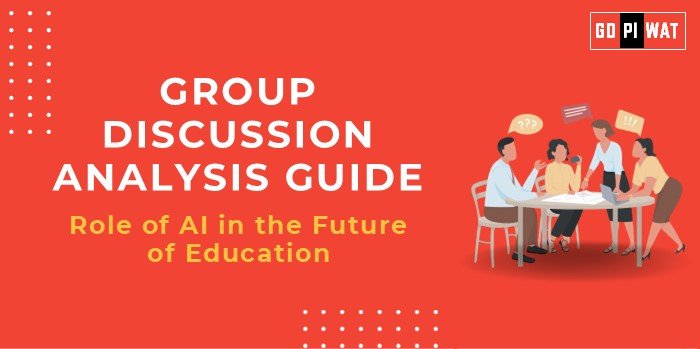📋 GD Analysis: Role of AI in the Future of Education
🌐 Introduction to Role of AI in Education
📖 With AI advancing rapidly, its potential to reshape education has become a focal point. AI-driven tools offer transformative possibilities, from personalized learning to enhanced administrative efficiency, making this a crucial topic for discussions on the future of educational systems.
AI’s integration into education includes adaptive learning platforms, automated grading, and AI-driven administrative processes. Its role is expected to grow as educators and institutions explore its potential further.
📊 Quick Facts and Key Statistics
- 🌍 Global EdTech Market Size: Projected to reach $605 billion by 2027, with AI driving significant growth.
- 📈 AI in Education Market Growth: Expected to grow from $2.75 billion in 2022 to $32.27 billion by 2030 at a CAGR of 36%.
- 🧠 Personalized Learning Impact: AI-powered learning can improve retention rates by up to 40%.
- 💰 Cost Reduction: AI tools could save 20-40% in operational costs by automating administrative tasks.
- 🇺🇸 Adoption in U.S. Schools: Over 60% of U.S. K-12 schools utilize AI technologies, highlighting its rapid integration.
🤝 Stakeholders and Their Roles
- 🏛️ Government and Education Ministries: Promote AI policies, fund research, and set ethical standards.
- 🏫 Educational Institutions: Integrate AI tools to enhance learning and streamline administration.
- 💻 Technology Companies: Develop AI-based tools and collaborate with institutions for implementation.
- 👩🏫 Teachers and Students: Engage with AI for personalized learning and new skill development.
- 👨👩👧👦 Parents and Society: Support AI initiatives for improved outcomes and readiness for tech-driven careers.
🎯 Achievements and Challenges
🌟 Achievements:
- 📚 Personalized Learning: Platforms like DreamBox provide tailored learning experiences.
- 📑 Efficiency in Administration: AI tools reduce workload, saving 20-40% in operational costs.
- 📈 Increased Engagement: Interactive AI platforms sustain student motivation and interest.
- 🌍 Global Comparison: China’s AI classrooms and U.S. AI tutoring platforms demonstrate successful adoption.
⚠️ Challenges:
- 🔐 Data Privacy: Managing student data responsibly is a significant concern.
- 🎓 Teacher Training Gaps: Educators often lack the training to use AI tools effectively.
- 📉 Equity Issues: Limited access in low-income or rural areas contributes to the digital divide.
- 📖 Case Study: South Korea’s “AI School” initiative highlights both benefits and challenges.
📄 Structured Arguments for Discussion
🔹 Supporting Stance: “AI is revolutionizing education by enabling personalized learning and operational efficiency, leading to significant cost savings.”
🔹 Opposing Stance: “While AI enhances education, it may reduce creativity and critical thinking by making students over-reliant on technology.”
🔹 Balanced Perspective: “AI in education offers vast potential but requires careful handling to address privacy concerns and teacher involvement.”
📊 Effective Discussion Approaches
- 📈 Fact-Based Start: “With the EdTech market projected at $605 billion by 2027, AI’s impact on education is undeniable.”
- 🔗 Problem-Solution Angle: “AI promises educational benefits, but the digital divide requires urgent attention to prevent unequal access.”
- ⚖️ Comparative Introduction: “While AI-enabled classrooms are common in China, challenges persist globally in achieving similar results.”
Counter-Argument Handling:
- 🔐 Data Concerns: “While privacy is crucial, strong policies can enable AI to benefit students securely.”
- 💡 Creativity Reduction: “AI doesn’t replace creativity; instead, it allows teachers to focus more on critical and creative teaching aspects.”
💡 Strategic Analysis
Strengths:
- 🌐 Expands access to education.
- 🧠 Enables personalized learning.
- 📑 Supports operational efficiency.
Weaknesses:
- 🔐 Privacy concerns.
- 📉 Potential over-reliance on technology.
Opportunities:
- 📘 New learning methodologies.
- 🔧 Skill development for a tech-driven future.
- 🌍 Potential global leadership in AI education.
Threats:
- ❌ Job disruption for traditional educators.
- ⚠️ Ethical concerns in AI deployment.
📚 Connecting with B-School Applications
- 💼 Real-World Applications: Projects on cost reduction, operational efficiency, and AI-based management.
- 🎓 Sample Interview Questions:
- “What are the ethical considerations of using AI in education?”
- “How can AI help reduce costs while improving education quality?”
- “In what ways can AI be integrated into management practices in education?”
- 💡 Insights: Highlights areas like tech-driven management, ethics, and opportunities for innovation.


